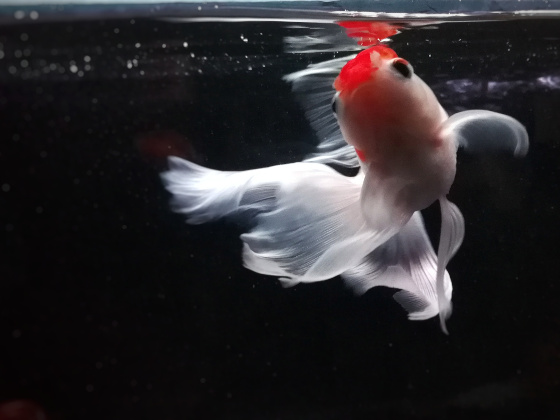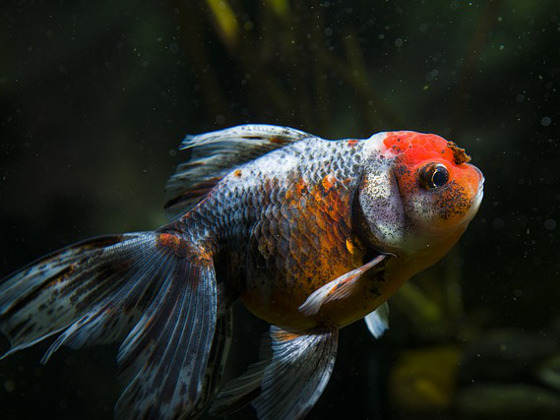There are so many varieties of goldfish available nowadays, and with more being developed through selective breeding as we speak. What is so interesting about Oranda goldfish is that although it is one of the older breeds of goldfish, it is still very popular and sought after by hobbyists.
So what is it about Oranda goldfish that makes it still relevant?

1) It has a hood
A hood or wen is a fleshy growth on top of the goldfish’s head. Oranda goldfish breed has a very prominent hood on its head. In fact, it is believed to be the first goldfish breed that has this hood. The hood can grow so big that it covers the whole of the goldfish’s head, except for the eyes and mouth (hopefully).
 Although some people dislike it because they think it looks like a cancerous growth, the hood on an Oranda goldfish is very favorable among hobbyists. It is so favorable that other subsequent breeds such as Lionhead and Ranchu are bred with this characteristic.
Although some people dislike it because they think it looks like a cancerous growth, the hood on an Oranda goldfish is very favorable among hobbyists. It is so favorable that other subsequent breeds such as Lionhead and Ranchu are bred with this characteristic.
There are many cases where it grew too much until it obstructs the goldfish’s vision. In this case, a portion of the hood will need to be trimmed off to restore the eye sight, or else the affected goldfish will have a problem finding food.
The hood on Oranda goldfish will slowly show as the fish grows to 3 or 4 months old. It will only get more prominent at the age of 1 to 2 years old.
2) It has an egg-shaped body
Oranda is a fancy goldfish breed that has a rounded, egg-shaped body. This body shape gives the goldfish an adorable outlook and a wobbly swimming style. These contribute to Oranda goldfish’s cute character that is very popular among goldfish keepers.
With this egg-shaped body, the Oranda breed is basically a slow swimmer. They are best kept with other slow swimming fish so that they are able to compete for food.

So what about Oranda goldfish’s growth? How big can they get?
Well, you should know that goldfish in general can grow very big. The egg-shaped bodied ones such as the Oranda can easily grow more than 6″ in length if kept well.
So it is necessary to provide them with enough space. A good guidance is at least 20 gallons for the first goldfish, and additional 10 gallons each for subsequent ones.
Due to this body shape too, the Oranda goldfish breed is prone to swim bladder disease. So it is important to maintain a good water condition and to provide them with the right food.
3) It has long flowing fins
Take a look at the Oranda goldfish in this video.
Did you see how its long flowing fins move as the Oranda swims around. The movement of the long flowing fins gives this almost magical kind of visual effect, as if you are watching a graceful dancer with a long flowing dress on stage.
 Oranda has a long dorsal fin, something which is missing on the Lionhead and Ranchu goldfish breeds that share the same hood and egg-shaped body characteristics.
Oranda has a long dorsal fin, something which is missing on the Lionhead and Ranchu goldfish breeds that share the same hood and egg-shaped body characteristics.
Other fins on the Oranda goldfish are paired, and the caudal fin (the tail) is four-lobed and tend to spread out broadly when it stops swimming.
4) It is colorful
This breed comes in different variations in terms of scales and colors. There are those with metallic scales, matte scales and a mixture of both which is called calico.
There are many color combinations as well. They can be of one solid color such as white, red, orange, black, chocolate and blue. They can come in a combination of colors as well, such as red/white or tri-colored such as red/white/black.

5) It comes in different variations
Within the Oranda goldfish breed itself, there are selective breeding to enhance selected traits such as the head growth, the fins and the body to produce different variations of Orandas.
For an example, there is this variation called the Red Cap Oranda. This variation is basically bred to have an all white body and fins, but with a bright red colored hood. Red Cap Oranda is very popular among the Oranda variations.

There is also a short finned version of Oranda which is called the Ingot. I personally really like this variation because it is sooooooooo adorable! I haven’t had the chance to own one yet, but I would really love to!
Well then there are variations that have massive hood. I don’t like these variations as I think the head growth on these are just too much.
Summary
Although Oranda goldfish breed is one of the oldest breeds in the goldfish world, it continues to be very popular with goldfish keeping hobbyists. This is because it has the characteristics that make it still attractive in the eyes of the goldfish keepers.
The hood (or wen) on its head, the cute egg-shaped body and the long flowing fins give the Oranda goldfish a beautiful, elegant and distinct character. The variations of scales and colorations also add to its appeal.
This breed also continues to be interesting with the emergence of variations targetted to enhance specific traits such as the Red Cap Oranda and the Ingot Oranda.
All these are the reasons why hobbyists are still talking about Oranda goldfish. It may be an old breed of goldfish, but it is certainly still very relevant with all the interest and attention that it is still getting.
What are your thoughts on this? What do you think is the most attractive about Oranda goldfish?
Note: The following contain affiliate links. For more information, please visit my disclosure page.
